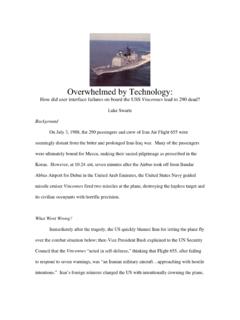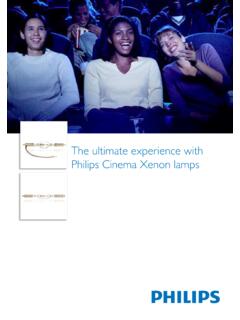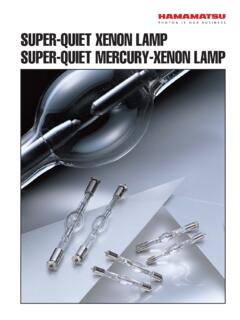Transcription of The “Mozart Effect”: Does Mozart Make You Smarter? Luke ...
1 The Mozart effect : Does Mozart Make You Smarter? Luke Swartz CS 99L How are we to know? Professor Nils Nilsson 2 The Mozart effect : Does Mozart Make You Smarter? Introduction In the October 14, 1993 issue of Nature magazine, UC Irvine researchers Frances Rauscher, Gordon Shaw, and Katherine Ky published a short, one-page article entitled Music and spatial task performance, which detailed their research involving exposing college students to 10 minutes of Mozart s Sonata for Two Pianos in D Major (K. 448), a relaxation tape, or silence, followed by a test on spatial reasoning, taken from the Stanford-Binet intelligence test. Their research showed a statistically significant rise in scores from those students who had listened to the Mozart sonata. The popular response was phenomenal. Newspapers around the country christened their finding the Mozart effect , and the Mozart recording used in the study quickly sold out in the Boston area (Shaw 2000, 5).
2 In Georgia, Governor Zell Miller became so enthralled at the results of the study that, with Beethoven s Ode to Joy playing in the background, he called for the legislature to allocate $105,000 to give a free classical music tape or CD to every new mother in the state (AAAS 1998). Tennessee soon followed suit with a similar bill; Florida now requires day-care centers to play classical music, and a New York community college now has a Mozart effect study room (Gladwell 2000). Classical music radio stations latched on to the idea, one publishing a letter in its newsletter from a listener who claims that she turned on the station and immediately, my test scores improved (Brin 1998, 11). A cottage industry sprung up, as Don Campbell (a long-time advocate of music therapy) had the foresight to trademark The Mozart effect , adding fuel to the fire by publishing a book by that title.
3 The book actually only devotes two and a half pages 3 to the UC Irvine study, the rest of its pages filled with anecdotes, pseudoscience, and conjecture. One chapter even claims that music can alleviate AIDS, allergies, and Diabetes (Campbell 1997, 226-252)! A recent cursory search on turned up half a dozen compact disc titles, with names like Better Thinking Through Mozart , Mozart for Your Mind, a whole series of Music for the Mozart effect , and even Ultrasound Music for the Unborn Child (featuring Mozart s music). Is this intense reaction justified? Even the original researchers agree that the media have over-inflated the findings. One, Gordon Shaw, recently released a book, Keeping Mozart in Mind, which largely has the goal of communicating the real importance of his research to laypeople who have been led astray by the media-fed frenzy. His colleague, Frances Rauscher, has repeatedly denounced the over-reaction in the popular press.
4 I' m horrified and very surprised over what has happened, she said. It s a very giant leap to think that if music has a short-term effect on college students that it will produce smarter children. When we published the study results, we didn' t think anyone would care. The whole thing has really gotten out of hand (Jones 1999). In particular, she criticizes people who claim that children should listen to Mozart to make them smarter: I think the evidence is solid enough to say, Let s improve and expand our music education programs for young children, but there is no evidence that just listening to music will do anything. One of the things we have to be careful about is jumping to conclusions that we don t have data on at find that Mozart makes you smarter thing is quite a bit of a leap. (Viadero 1998). Others have noted that, while some of Don Campbell s claims are backed up by research in music therapy, if Mozart s music were able to improve heath, why was Mozart himself so frequently sick?
5 (Linton 1999). 4 While some researchers charge Rauscher and Shaw with adding to the hype, contributing to this excitement by linking the Mozart effect with the production of long-term cognitive enhancement through music education (Steele, Brown, and Stoecker 1999), most agree that the researchers were professionally circumspect with their media that reported them were not. (Linton 1999). Attempts to Replicate the First Experiment Although the media have exaggerated the extent of their findings, even Rauscher and Shaw were surprised that there would be such an easily measurable difference in spatial-reasoning task level after such a short exposure to the music. As a result, both they and other researchers have attempted several times to replicate the findings of the 1993 experiment, to assess its validity and determine the extent of the Mozart effect . Such attempts to reproduce the 1993 have met with mixed results; some have, indeed, reproduced the findings, while others fail to show a significant effect of listening to Mozart s music.
6 How can this be explained? One explanation offered by Rauscher and Shaw is that the Mozart effect only applies to certain spatial-temporal tasks (Rauscher and Shaw 1998, 837-838). Upon re-analyzing their original 1993 study, they found that while subject s scores on the Pattern Analysis and Matrices tests improved slightly, the only significant improvement was shown in the Paper Folding and Cutting (PF&C) task, a spatial-temporal task (836-837). Indeed, experiments involving different, non-spatial-temporal tasks as dependent measures largely failed. Two studies using Raven s Advanced Progressive Matrices (APM) failed to show any significant improvements by subjects who listened to the same Mozart sonata used in the 1993 study (Newman et al. 1995; Stough et. al. 1994). While the researchers 5 emphasized that the Raven s tests are regarded as general tests of intelligence which require spatial aptitude, inductive reasoning and perceptual qualities underlying spatial IQ (Stough et.)
7 Al. 1994), others note that APM tests spatial recognition using physical similarities [in] visually presented stimuli while PF&C, mental rotation, and jigsaw puzzles require mental transformation of the stimuli (Nantais and Schellenberg 1999). Another study attempted to replicate the Mozart effect using the Revised Minnesota Paper Form Board Test, which involves mental rotation of two-dimensional figures, also failed to show a statistically significant result (Carstens, Huskins, and Hounshell 1995). Although the test does involve mental rotation, the researchers noted that the Revised Minnesota Paper Form Board Test is a Spatial Orientation test, while the tasks used by Rauscher and Shaw in their 1993 study are Visualization tests (Carstens, Huskins, and Hounshell 1995). Likewise, an attempt to show the Mozart effect using a backwards digit span task in which participants had to recite a list of digits backwards also failed (Steele, Ball, and Runk 1997).
8 The researchers claimed that the task is of interest as a spatial reasoning task because it requires rotation or transformation of the sequence (1180) but acquiesced that the task is only quasispatial and thus the failure to replicate could be attributable to the different dependent measure (1182). While attempts to reproduce the Mozart effect using non-spatial-temporal tasks have largely failed, researchers using spatial-temporal tasks have been able to replicate the 1993 findings, albeit to a lesser degree. One group of researchers testing the theory using mazes (a spatial-temporal task) noted that the Mozart effect received support from our data (Wilson and Brown 1997, 368). A former skeptic, Eric Siegel of Elmhurst College, tried to disprove the theory using a test in which subjects had to rotate the letter E, and found to his surprise that 6 subjects who listened to Mozart performed better.
9 It was as through they had practiced the test, he exclaimed (Kliewer 1999). The most prevalent and successful measure of the Mozart effect , however, has been using the Paper Folding and Cutting subtest of the Stanford-Binet intelligence test (PF&C). An example PF&C question; subjects are told that the paper is folded and cut as shown on top, and asked which of the letters corresponds to the unfolded paper (in this case, the answer is C). One study, entirely controlled by computer, tested PF&C items and found that subjects who had listened to Mozart did better than those who sat in silence (Nantais and Schellenberg 1999). Another study tested two different PF&C items, and found that Mozart listeners did better than those who listened to a relaxation tape (Rideout, Dougherty, and Wernert 1998). The researchers noted that the effect was not dramatic, but nonetheless reliable in the predicted direction (Rideout, Dougherty, and Wernert 1998).
10 The original researchers also re-tested their theory using both a PF&C task as well as short-term memory; Mozart listeners improved in PF&C performance but not in the memory task (Rauscher, Shaw, and Ky 1995). They emphasized that the PF&C task is not simply a spatial recognition task; it is a temporal series of spatial tasks (Rauscher, Shaw, and Ky 1995, 46). 7 Nevertheless, not all attempts to reproduce the Mozart effect findings using PF&C have succeeded. One study used PF&C tasks as well as matrices, and found no significant difference between the spatial task performance scores of subjects in the two conditions, although the researchers note cryptically that post-hoc analyses provided some interesting findings but do not elaborate what these analyses or findings were (Kenealy and Monsef 1994). A series of studies done in 1999 also failed to replicate the Mozart effect despite using PF&C tasks (Steele et al 1999).







